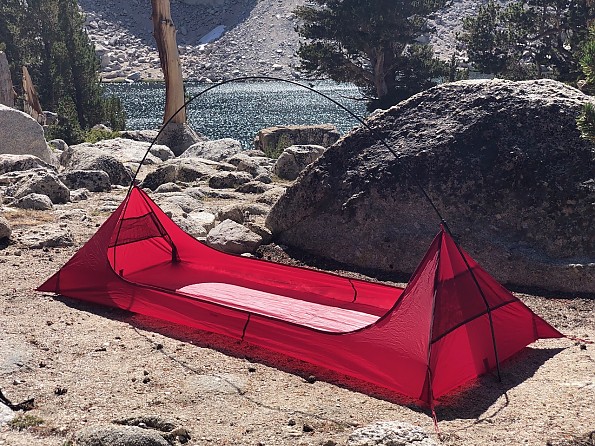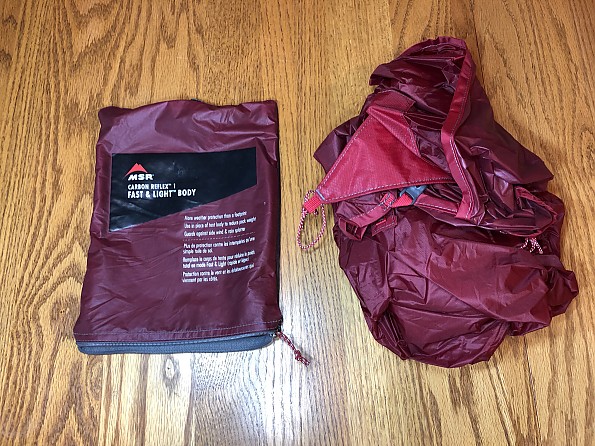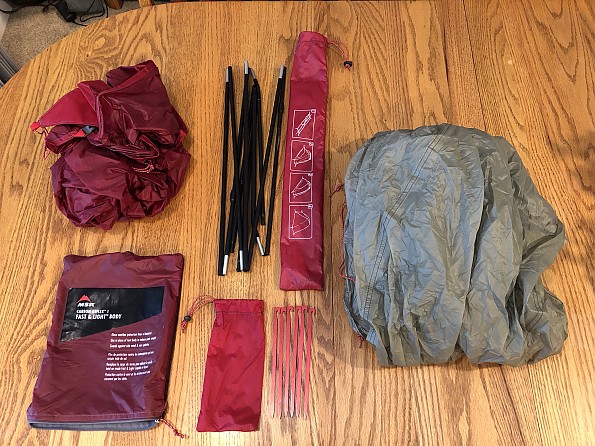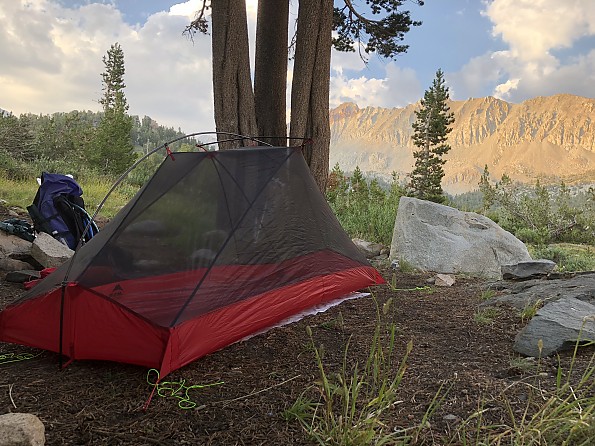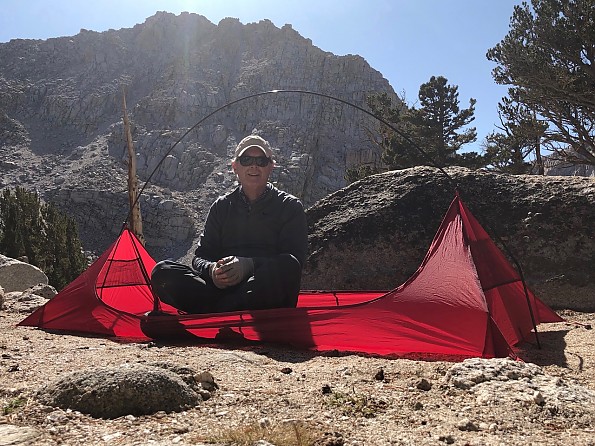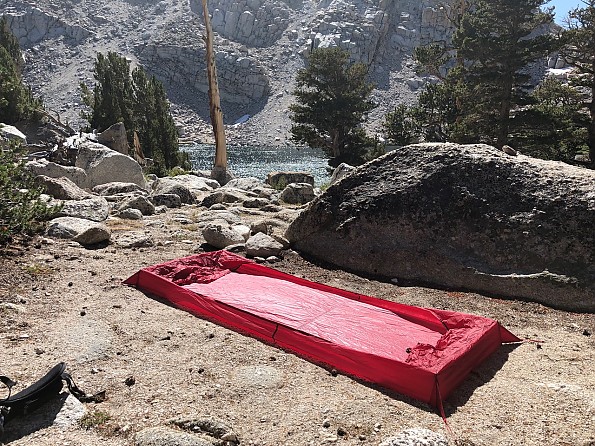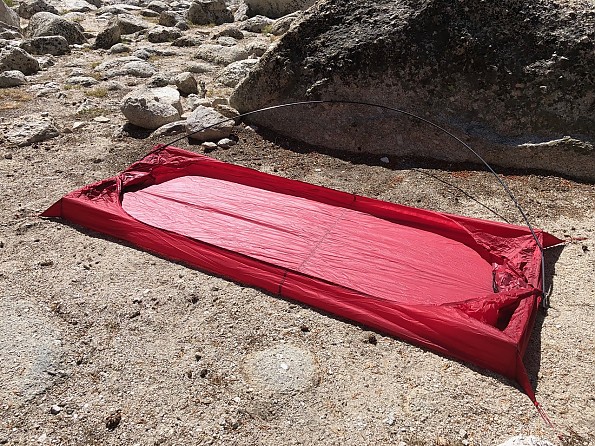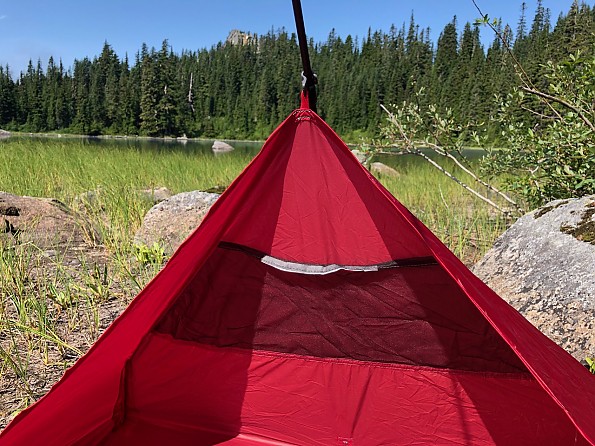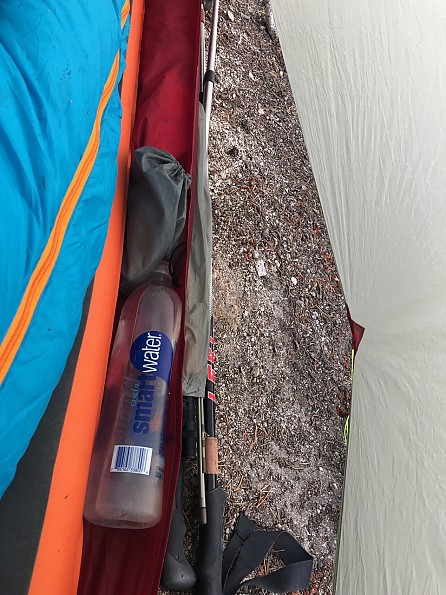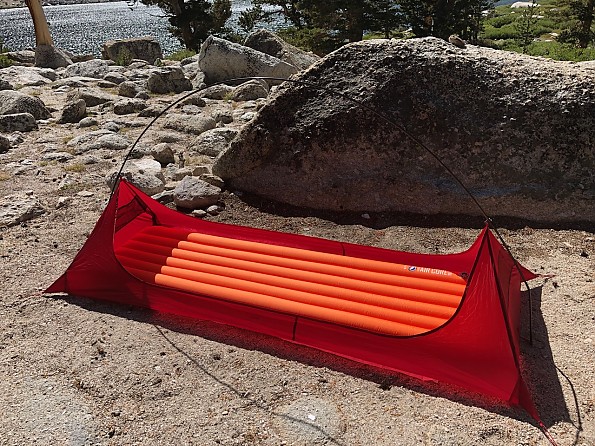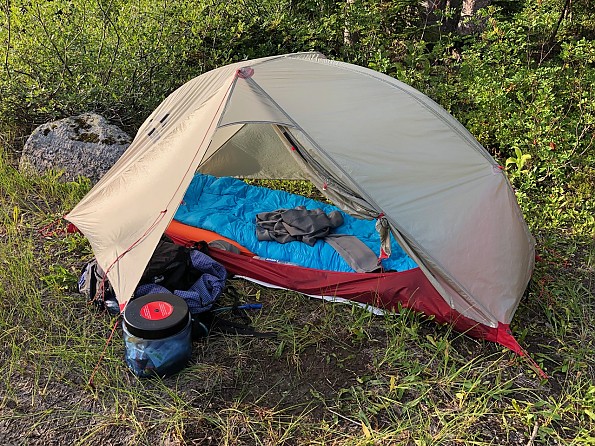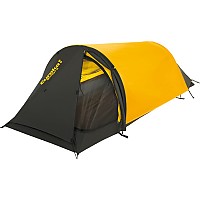MSR Carbon Reflex 1 Fast & Light Body
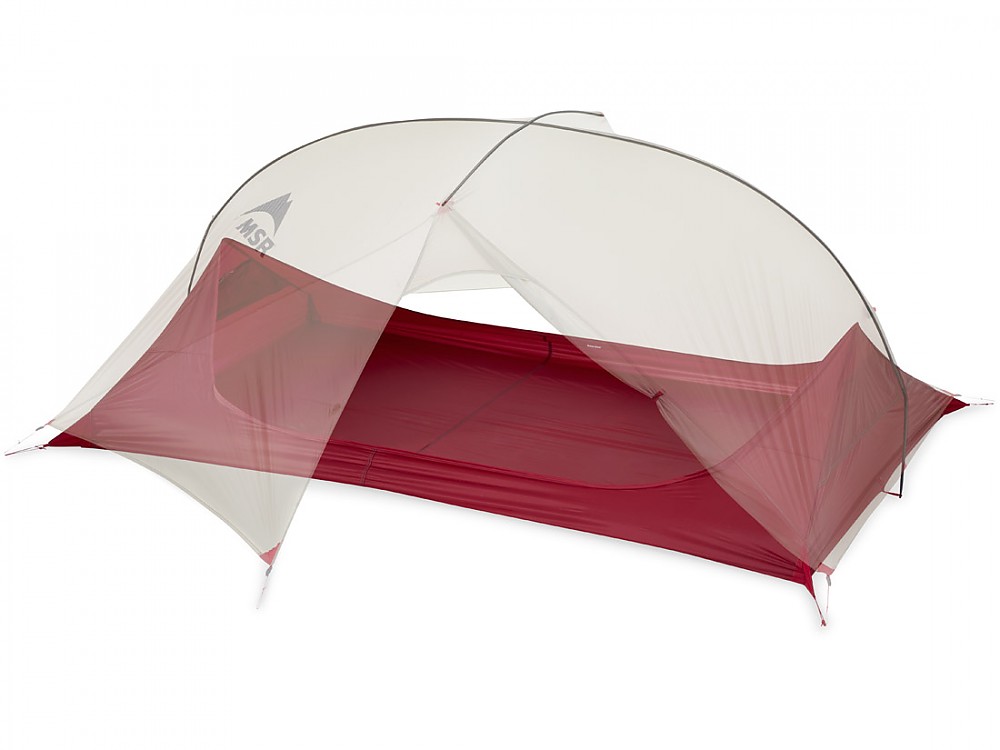
The MSR Carbon Reflex 1 Fast and Light Body is a replacement option for the Carbon Reflex 1 tent body. It provides greater protection from the elements when compared to a typical footprint, but still utilizes the fly, poles, and stakes of the Carbon Reflex 1 tent to provide good overall weather protection.
Using the Fast and Light Body gives you an optional shelter configuration that is lighter weight and provides significantly more interior space when conditions don’t require a bug resistant enclosure. The Fast and Light Body has the same quality construction as the Carbon Reflex 1 tent and makes a nice option for those looking to gain some versatility with the investment already made with their Carbon Reflex 1 tent.
Pros
- Great headroom, interior room, and access to items under vestibule
- Nice lightweight option that takes advantage of tent components already owned
- Provides better protection then just a basic footprint
- Very nice and accessible mesh storage pockets at each end—perfect location when you are in your sleeping bag
- You gain an additional small vestibule if you use tie out on normally flat/vertical side of the tent.
- Quality MSR construction
Cons
- Hooks that mate to the peak at each end of the Fast and Light Body to the center pole have too loose of a fit and won’t hold up each end of the Fast and Light body until after the fly is installed.
- Not a significant weight savings, only 3.6 ounces
- The fly doesn’t center on main pole very well without tent body.
Overview
I did a review of MSR’s Carbon Reflex 1 a while ago (here is a link to the review) which was MSR’s lightest double-walled solo tent design at the time, and in doing some research on the MSR website on the Carbon Reflex 1, I noticed a new product that MSR had introduced called the Carbon Reflex 1 Fast and Light Body.
I was intrigued by the concept of the Fast and Light Body which uses the fly, poles and stakes from the Carbon Reflex 1 tent to create a lighter weight shelter that can be used when conditions don’t require bug protection or when there is a desire is to have the lightest weight shelter possible. Due to the bathtub design of the Fast and Light body, it provides an additional level of weather protection over a basic footprint which is another potential option.
MSR sells the Fast and Light Body in a 1-, 2-, and 3-person option for all of their Carbon Reflex tents, in addition to the Zoic, FreeLite, and Hubba lines of tents.
This review won’t be as extensive as the review I did on the Carbon Reflex 1, which I found to be a really great option The focus instead will be on the Fast and Light Body and how it integrates with the fly and poles from the Carbon Reflex 1.
I have structured this review into the four main sections listed below, followed by a summary at the end.
- The Basics of what is included with the Fast and Light Body
- Physical Characteristics of the Fast and Light Body
- Design and Construction
- Living with the Fast and Light Body
The Basics of What is Included
The Carbon Reflex 1 Fast and Light Body comes packaged in a zippered pouch as shown in the picture below.
To actually use the Fast and Light Body you also need to have the poles, stakes, and fly from the Carbon Reflex 1 tent. All of those items along with the Fast and Light Body are shown in the picture below.
The Fast and Light Body does come with reflective cord loops pre-tied at all four corners for use in staking out the body, so it's ready to use right out of the package.
Unlike the Carbon Reflex 1, MSR does not provide any instructions on how to use the Fast and Light Body itself, so I am assuming that MSR feels that if you already are familiar with the tent then you shouldn’t need much help in using the Fast and Light Body, which for the most part is true.
MSR does have a very general video on how to use a Fast and Light Body, but it is done with a multi-person tent where the Fast and Light Body assembles in a more straight forward manner, but using the Fast and Light Body with the Carbon Reflex 1 pole and fly is not as intuitive. I’ll get into this topic more when I discuss the design below, but MSR should have provided more guidance on how to use the Fast and Light Body with the Carbon Reflex 1.
Physical Characteristics of the Fast and Light Body for the Carbon Reflex 1
Weight:
The primary selling point of the Fast and Light Body is weight. So when I weighed the body I found the measured weight to be right in line with the weight that MSR advertises for the Fast and Light Body for the Carbon Reflex 1. I have provided the actual values listed below that I measured compared against the MSR published weights.
Fast and Light Body Weight:
- MSR published: 7.0 ounces
- Actual Measured: 7.1 ounces for body and pouch. Fast and Light Body alone was 6.7 ounces and the pouch was 0.4 ounces
As stated earlier, to actually use the Fast and Light Body you need to bring along several items from the Carbon Reflex 1 tent. I have listed the minimum items I brought along on trips when using the Fast and Light Body along with their weights below.
Weight of the individual components:
- Tent stuff bag: 1.1 ounces
- Fly and guy lines: 8.4 ounces
- Poles: 5.3 ounces
- Pole stuff sack: 0.35 ounces
- Stakes (6): 2.1 ounces
- Stake stuff sack: 0.15 ounces
- Total weight of the above items: 17.4 ounces
So a combined weight for the Fast and Light Body and the additional needed tent components is 24.1 ounces
The total weight for my Carbon Reflex 1 tent/fly was 27.7 ounces, so going with a Fast and Light Body really only saves me about 3.6 ounces which is something when you are trying to shave ounces out of your pack, but from my perspective not significant for what you give up in bug protection.
Packed Physical Size
The packed size of the Fast and Light Body along with the other components that you need from the Carbon Reflex 1 is noticeably smaller then what is required for the Carbon Reflex 1 tent if it was being carried.
In actual use I have been packing the Fast and Light Body and fly in the large stuff sack that was included with the Carbon Reflex 1 tent and that would be stuffed down inside of my pack. I would then pack the poles and stakes in the stuff sack included for the poles and that would go in one of the side pockets on the outside of my pack.
Assembled/Setup Size
MSR doesn’t provide any physical dimensions on their website for the Fast and Light body for the Carbon Reflex 1, but I found that the basic length and width were the same as the Carbon Reflex 1 tent (approximately 84.0 by 34.0 inches). The sidewall height of the bathtub floor was approximately five and a half inches and the peak height at each end was approximately nineteen and a half inches.
One notable difference is the width across the top of the opening of the walls of the bathtub floor which is only about 24 inches on the Fast and Light Body where it is about 29.50 inches on the Carbon Reflex 1 tent. The difference is more apparent in the photos below where you can see how the walls of the Fast and Light Body slope back towards the center pole compared to the tent where the walls of the bathtub floor are held vertical by the cross pole and netting side walls.
The most significant difference I noticed between the Fast and Light Body and the Carbon Reflex 1 Tent is headroom interior space. While I really like the Carbon Reflex 1 tent, the overall headroom is only a little over 33.0 inches. With the Fast and Light Body the headroom is all the way up to the crest of the poles, which is over 35.0 inches and with the Fast and Light Body all the space under the fly is available for use.
Design and Construction
With the Fast and Light Body for the Carbon Reflex 1 there are both good and not-so-good aspects with the design. From the good perspective, the Fast and Light Body is made from the same 15 Denier Ripstop nylon with a 1200 MM Xtreme shield coating which is same as the most recent version of the Carbon Reflex 1 tent floor. It also has the same robust design details and quality methods of construction as I found with my Carbon Reflex 1 tent.
With the not-so-good, MSR really could have tried to do a better job with how each end of the Fast and Light Body for the Carbon Reflex 1 attaches to the main pole. The peak at each end attaches to the main pole by means of a hook with a loose fit that is the same as what is used on the tent to attach to the mesh tent body to the main pole. The problem with this approach is that there is nothing to retain the hook when it is attached to the pole so it ends up just sliding down to the end of the pole. The end result is that the pole won’t stay upon its own which would make it much easier to attach the fly.
It’s easier to show the issue in the following series of pictures.
The first step in setting up the Fast and Light Body is to stake out the four corners as shown below.
The next step is to assemble the main pole and insert it into the feature at each end of the tent and then attach the hook at each end of the Fast and Light Body to the pole. Because the hooks are a loose fit on the pole they just slide to the end and since the pole can’t hold itself up it falls over as shown below.
It may seem like all hope is lost at this point, but in the end you can still attach the fly, but it becomes a juggling act because you have to hold the main pole up while you are attaching the fly to each corner stake and then crawl inside and Velcro the fly to the main pole. Once the Velcro from the fly has been attached at each end of the pole that gives you a feature to hook the peak of each end of the Fast and Light Body above that will hold the hook in its intended position, but it’s a hooky way to set up a tent.
After using the tent once like described above I knew I would go nuts if I had to continue to go through the same setup routine, so I implemented a small fix to maintain my sanity. What I ended up doing is simply wrapping a small amount of electrical tape around each end of the main pole so that it created a stop for the hooks to rest against like shown in the picture below.
With the stops added to the main pole it becomes free standing (like is shown on the MSR website) and then it is an easy task to install the fly. I don’t know if I would recommend this approach as composites can be very sensitive to chemicals like the adhesive on the tape, but I think it would be great if MSR could include a small roll of composite friendly tape or some other item that can be added to the pole to create a stop or use a snap fit hook instead of the loose fit.
This issue is unique to the Fast and Light Body for the Carbon Reflex 1 as all of the multi-person versions of the Carbon Reflex have a feature on the main poles that the hooks can rest against.
One feature of the Fast and Light Body that I really like are the mesh storage pockets that are located at each end of the Fast and Light Body. The storage pockets are nice and large and in a perfect location when you are in your sleeping bag as it is very easy to reach behind your head and place or retrieve things from the storage pocket.
Living with the Fast and Light Body for the Carbon Reflex 1
Since I had already been using the Carbon Reflex 1 tent for a season I was familiar with the basic tent and fly, so using the Fast and Light Body was very easy to pick up, especially once I added a stop feature to the poles for the hooks of the Fast and Light Body to rest on. One of the primary issues I had with the Carbon Reflex 1 tent was that it was a little confining and I was looking forward to the more open experience with the Fast and Light Body and I wasn’t disappointed.
With the fly installed there really is a nice amount of usable space within the Fast and Light Body and the two vestibules. Normally with the Carbon Reflex 1 tent there is only a single vestibule under the fly by the door of the tent, but when using the Fast and Light Body you can stake out the normally vertical side of the fly and this makes a smaller but usable vestibule opposite the door.
Here are a couple of photos showing what it looks like inside the fly with a normal setup.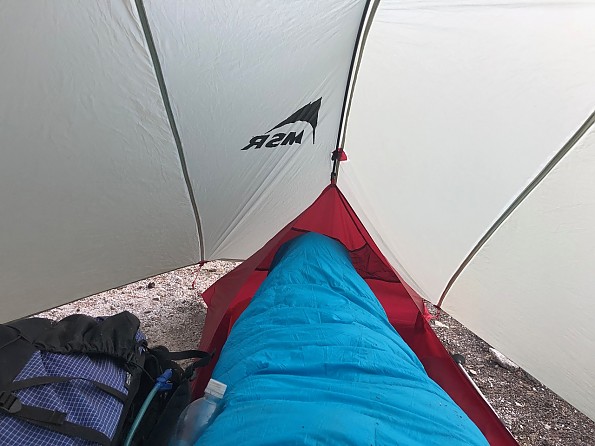
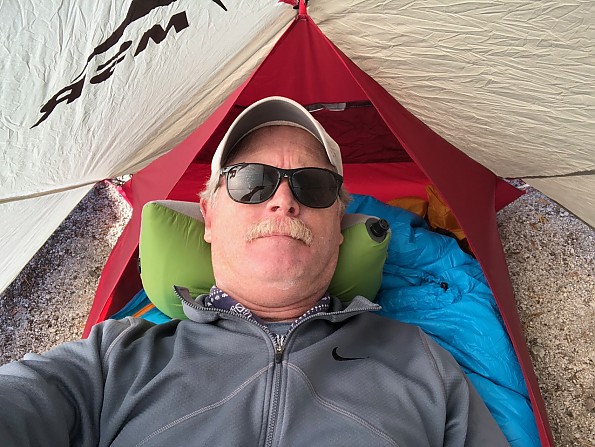
And here is a photo of the bonus vestibule.
Floor space in the Fast and Light Body is adequate for your basic sleeping gear and is less of an issue due to the easy access to the primary and secondary vestibules to get any gear out of your pack, etc. The pictures below are from one trip where I was using my Big Agnes Air Core Ultra, which is a 20" x 78" mattress configuration, and it gives you a good idea of the space remaining at the head and foot areas. The sidewalls along the side of the mattress do a good job of keeping smaller items handy and secure, which might be more of an issue if you were just using a footprint under the fly instead of the Fast and Light Body.
The overall experience with the Fast and Light Body and the fly is much like the first time you go commando in that everything is much more open compared to the more confining experience when using the Carbon Reflex 1 tent.
With respect to how the Fast and Light Body worked with the fly in adverse weather, I did experience a night where it rained lightly throughout most of the night and didn’t experience any moisture getting on my gear. I also had one night where the fly was getting buffeted pretty significantly through most of the night and it held up well without any issues. So overall, I think the Fast and Light Body combined with the fly from the Carbon Reflex 1 tent make a good combination for most conditions.
I think the Fast and Light Body may be the preferred option over using the Carbon Reflex 1 tent in colder conditions. The Carbon Reflex 1 tent is on the small side, so in colder conditions where you are wearing several layers of insulation and have a heavier sleeping bag, you will have that much more of an issue getting through the zippered doorway of the tent body and moving around inside the tent when there is no real need for the netted enclosure. Using the Fast and Light Body would provide a much more roomier environment. If snow was expected then the Carbon Reflex 1 tent may provide some additional structure to help carry the snow load along with the fly, which would be something to consider if you were planning a trip in winter conditions.
The list price of the Carbon Reflex 1 Fast and Light Body is $99.95, which I think is a fair price for what you are getting and it would be an even better price if MSR addressed the issue of how the hooks at each end of the Fast and Light Body attach to the main pole.
Summary and Recommendation
When someone switches from using the Carbon Reflex 1 tent to the Fast and Light Body they will maintain a good weatherproof shelter and gain a significant amount of usable interior space while saving about 3.6 ounces of weight, but at the same time they'll give up the bug protection and protection from other creepy crawly things like snakes, spiders, ground squirrels, etc. that comes with the netted enclosure of the tent.
In general, I think most users will find the Fast and Light Body as a nice option for trips during the shoulder seasons or in alpine environments where there are fewer bugs. For me personally, I feel the greatest benefit is the ability to take advantage of all the space under the fly and I think other users who would like the extra space to sort gear or have a place for the dog to sleep will appreciate the more open environment afforded by the Carbon Reflex 1 Fast and Light Body.
Many thanks to both Trailspace and MSR for the opportunity to evaluate and test the MSR Carbon Reflex 1 Fast and Light Body for the Trailspace Gear Review Corps!
Background
I have been using the Carbon Reflex 1 Fast and Light Body for a number of trips this past spring and summer in western Washington state and also down in the southern Sierras in California. I have been backpacking since the mid 1970s and have had the opportunity to own and use a variety of tent designs from various outdoor tent manufactures over the years.
Source: received for testing via the Trailspace Review Corps
(Sample for testing and review provided by MSR)


